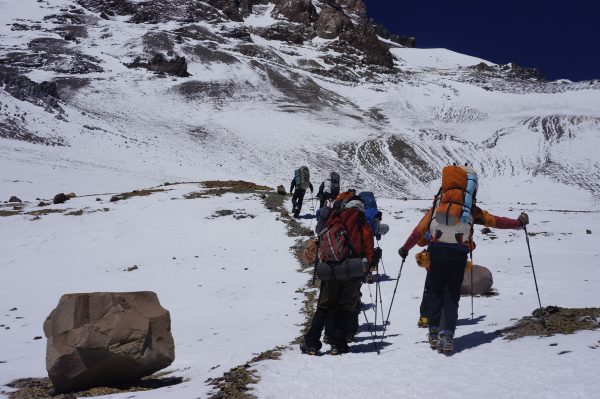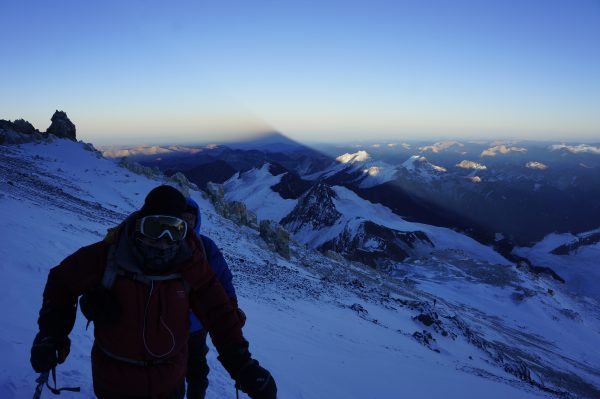Water Purification
Most climbers on Aconcagua experience some amount of gastrointestinal distress at some point on their trip. Our bodies are accustomed to the bugs and microbes in our local water, and anytime we travel, it is easy to ingest something that will give our guts a bit if a challenge. It is important to be cautious when eating and drinking before your climb, so as to minimize the chances that you’ll get “the runs” before you hit the trailhead.
- Drink bottled water in Mendoza. The tap water is generally excellent, but why take chances?
- “Dry brush” when you brush your teeth, meaning don’t rinse your toothbrush before putting it into your mouth.
- Try not to get water in your mouth when showering.
- Avoid fruits that can’t be peeled.
- Perhaps hold off on that good looking Cesar Salad that the people at the next table just ordered.
The bottom line is that it’s OK to be cautious and even a little bit paranoid before your trip.
On The Mountain
We’ll be pulling our drinking water from streams for most of the trip. It is generally easy to find clear water, so you’ll not need to worry so much about filtering it, rather you’ll need to purify it before drinking. 
When possible, fill your bottles from quick moving flows of water, rather than from still pools. On the first days of the approach, you’ll stop at small streams to fill bottles so this should be easy. Hike uphill from the trail a ways before filling, as the water might be a bit more clear where the stream bed has not seen foot and mule traffic.
Whatever purification system you have chosen, remember to let some of your treated water dribble down over the threads of your bottle before sealing it up to wait for the purification process to commence. It is important to treat not only the water in your bottle, but also the water that you’ll touch along those threads when you take your first sips.
The guides will be able to boil some water, but there are many reasons why chemical purification is a better system on a 2-3 week expedition. For instance, if you use iodine treated water to boil pasta, you’ll end up with some funny colored pasta when the iodine reacts with the starch in the water! All water for hot drinks and for cooking will be boiled, so don’t fret about drinking your fill of soups and hot cocoa.
At the upper camps, we might need to dig through snowfields to find water running underneath or we might need to melt snow. Water from melted snow still needs to be treated! The strong winds so legendary on Aconcagua transport sediment that can potentially contain bacteria over long distances, making snowfields somewhat suspect as a water source.
Human Waste
My sons have a great book, written in Spanish, called Todos Caca. Yup- Everyone Poops. Our challenge on Aconcagua is how do we manage our human waste in a manner that does not contribute to the problem for which the mountain is notorious. The mountain is much, much cleaner than it was a decade ago, and we want to keep that trend moving in the right direction.
We will be using a system called WAG Bags. You will be provided several WAG Bags, which are small, packaged systems for collecting and transporting human waste. When you tear open the packaging, you’ll find a thick, heavy duty zip lock back, and a larger bag with a small amount of what looks a lot like cat litter in the bottom. Each kit also contains a small bit of toilet paper and a handi-wipe towelette.
After finding a secluded spot, off the beaten track (ask your guides for directions), open your package, stow the zip lock so it does not blow away, and roll down the edges of the larger bag, in a manner so that you are rolling to the outside of the bag. The reason is so that you do not accidentally contaminate the outside of the bag in the event of a gust of wind or poor aim. Do not put liquid waste into the WAG Bag, as this will be unmanageable for transporting.
When you’ve finished, put all TP into the large bag, roll it up and place it into the heavy duty zip lock, making certain that the zip is locked! Voila! You’ve just done your part to help keep the mountain clean.
Bring a small, travel sized, bottle of hand santizer and use it liberally. The guides will also have some, but it is nice to have your own supply as well. The more pro-active you are, the less your chance of having the high-altitude trots will be.
The porters we employ might be willing to carry your full WAG bag back to Base Camp, but you will need to make private arrangements for this “above the call of duty” service. Ask your guides for more on this…
Liquid Waste and Wind
I think we may have mentioned that Aconcagua is a windy mountain. It is also one of the few places that I’ve seen the pretty gross phenomena of climbers walking around with a frozen glaze of pee all over their trousers and sometimes jackets. Disgusting.
Jim Croce sang “You don’t spit into the wind.” Get it?
If it is really windy, consider using your pee bottle to contain things and then pour it out low to the ground.
We know that this can be a challenging topic, and whom and how much to tip is a personal choice. How much to tip is a question that we get frequently, and in the past we struggled to come up with a good answer to this awkward question. We’ve decided to confront it straight on, and give you some ideas of “standard” tips.
On Aconcagua you will have two teams to which it is customary to give a gratuity. The first is your Mountain Trip guide team, and the second is the local support staff that help us along the way.
The local staff includes: van drivers, mule drivers, cooks and base camp staff, and porters. You will see during your expedition how much we depend on these folks and how hard they work to help us have a smooth and enjoyable expedition. Instead of each team member tipping these folks individually, we’ll typically pool our money and tip the local staff as a group. Generally each climber will contribute $100-$150 USD to this tip for the local staff. You may have a porter, or cook who goes above and beyond what you might expect, and you can certainly show your appreciation to him/her in addition to the group tip.
Your Mountain Trip guides will provide a lot for you while on the mountain, including but not limited to helping to keep you happy, healthy and fed, leading you and accompanying you to the summit, making weather decision, telling good (or bad) jokes, etc. Climbers generally tip their guides individually, a rough guideline is between $300 – $600 USD from each climber.
Obviously don’t feel limited by these general tipping guidelines, we just wanted to de-mystify the tip a bit and make you a bit more comfortable with whatever you choose to do.


